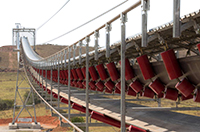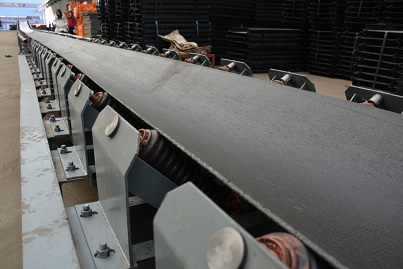The main driving parts of the belt conveyor are the conveyor belt, the roller and the idler. The inter-relationship of the various parts affects each other. The failure of any part itself will cause other parts to fail over time, thereby reducing the performance of the conveyor and shortening The life of transmission parts. This article analyzes and studies the causes of failure of other parts caused by transmission parts, and takes effective measures to improve.
1. Failure caused by conveyor belt
1.1 Failure of the roller
The failure of the roller mainly has the following 4 kinds:
â‘ In production, the conveyor belt tension F0 will gradually decrease (see Figure 1), reducing the friction between the conveyor belt and the roller, causing the roller and the conveyor belt to slip;
② Conveyor belt brings water, coal slime or dirty oil and other debris between the roller and the conveyor belt, causing the roller and the conveyor belt to slip;
③ The rubber surface of the roller is flattened or worn off, resulting in a reduction in the friction factor, resulting in a reduction in the friction between the conveyor belt and the roller, and causing the roller and the conveyor belt to slip;
â‘Ł Under the action of the tension of the conveyor belt, the roller shaft bearing is worn and damaged, causing its position to change, causing the conveyor belt to deviate or the roller and the conveyor belt to slip, causing work failure.
1.2 Failure of the roller
There are mainly three kinds of failures of idler:
â‘ During the working process, friction force is generated between the idler roller and the conveyor belt. The running direction of the conveyor belt and the rotation direction of the idler have a certain inclination. When the idler rotates, it is subjected to eccentric load, resulting in the surface of the idler and the bearing of the idler. As time goes by, the roller will break from the middle, the roller bearing will not rotate flexibly or rotate, and even cause the bearing to fall out, the roller surface and the bearing seat will crack, and the welding will cause the conveyor belt to run away. Malfunctions such as deviation, increased working resistance and material spilling;
②Conveyor belt brings water, coal slime or filthy oil into the contact surface of the roller and conveyor belt, so that the deposit enters the roller bearing, contaminates the lubricating grease, destroys the normal lubrication of the bearing, and causes bearing damage;
③The material on the conveyor belt is biased to one side, forming a partial load. The load on the roller on the side of the partial load increases, which accelerates the wear of the roller surface and the roller bearing, causing damage to the roller and causing work failure.
2. Failure caused by roller
2.1 Conveyor belt failure caused by incorrect roller position
During the installation or production process of the belt conveyor, due to the incorrect or change of the roller installation position, the roller is deflected (see Figure 2), and the axis of the head driving the roller or the tail reversing the roller is not perpendicular to the center line of the conveyor. The tightness of the belt on both sides of the drum is inconsistent, and the traction force Fq increases or decreases along the belt width, which will generate a moving component Fy between the drum and the conveyor belt, causing the conveyor belt to deviate to the loose side and cause work failure.
2.2 Conveyor belt failure caused by the change of roller diameter
Due to the processing error of the roller itself, the material sticking to the surface or uneven wear causes the diameter to change. The traction force Fq of the conveyor belt produces a moving component force Fy to the larger side of the roller diameter. Under the action of the moving component force Fy, the conveyor belt generates Deviation in a larger diameter direction will cause the conveyor belt to deviate upwards, as shown in Figure 3, causing work failure.
2.3 Failure caused by the bending of the conveyor belt on the drum
The conveyor belt will bend when it is rolled into the drum. When the number of bending reaches its fatigue limit, bending failure will occur. Small cracks will appear in the initial stage. Over time, the cracks will expand or tear, which will eventually cause the conveyor belt to break and cause work failure.
3. Failure caused by roller
3.1 Conveyor belt failure caused by incorrect roller position or material sticking to the surface
Due to the installation error of the supporting roller group, the position change during the production process or the adhesion of coal slime on the surface of the supporting roller will cause the conveyor belt to deviate to one side at this group of supporting rollers, causing work failure.
3.2 Conveyor belt failure caused by damage to the roller
After the roller is worn, the metal surface is cracked or the roller is lifted under the impact of the impact load, causing abnormal wear or scratching of the conveyor belt, or even torn, and finally causing the conveyor belt to break and cause work failure.
improvement measures
1. Timely inspection and maintenance
When the conveyor belt is slack on the roller and slips, adjust the tensioning force through heavy hammer tensioning, spiral tensioning, hydraulic tensioning and other devices to eliminate the slipping failure. However, when the conveyor belt is permanently deformed, the tensioning stroke is not enough, and a section of the conveyor belt can be cut off and joint vulcanized.
When debris such as water, coal slime or dirty oil appears on the surface of conveyor belts, rollers and rollers, they should be cleaned up in time to keep the surface of the transmission parts dry. If the environment is humid, rosin powder can be added to the rollers to prevent slipping.
When the surface of the conveyor belt is cracked, the rubber surface of the roller is damaged, or the idler is not running or damaged, it should be repaired or replaced in time, and the bearing lubricant should be cleaned and filled regularly, and work cannot be continued to prevent greater failures or safety accidents. .
2. The transmission parts are qualified and the technology meets the requirements
The quality of transmission parts such as conveyor belts, rollers and idlers should be qualified, and no work failure caused by the manufacturing errors of the rollers should occur. The installation and maintenance process of belt conveyor parts meets the requirements, and the error cannot exceed the standard. The conveyor should run smoothly to prevent overload or impact load.
In actual production, it is necessary to strictly implement the belt conveyor operation, inspection and maintenance systems, carefully analyze and judge the faults found, perform timely maintenance, avoid major accidents, and extend the transmission of conveyor belts, rollers and idlers. The service life of parts improves production efficiency.








